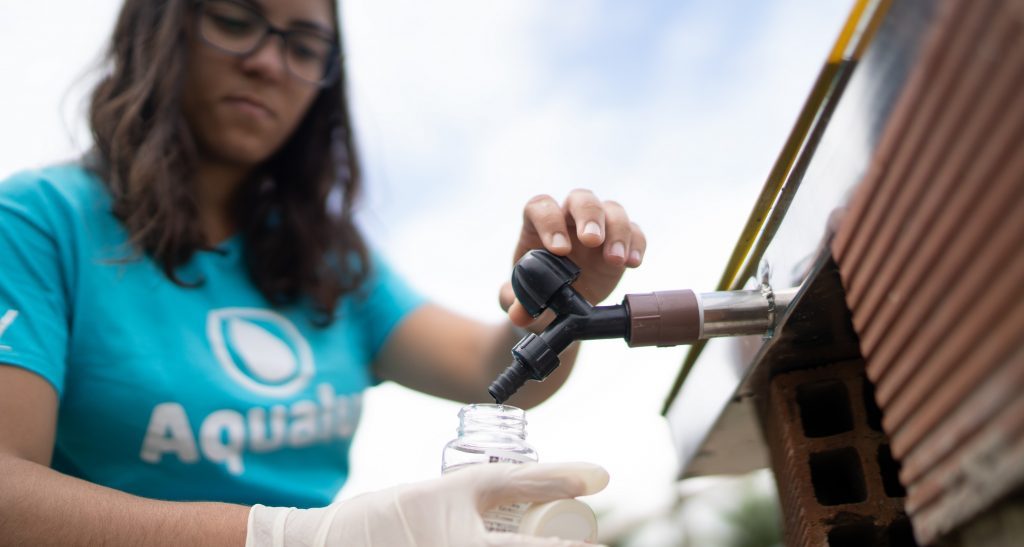São Paulo – Anna Luísa Beserra is 21 years old, and hers is a story of dreams achieved. Her latest accolade was the UN Environment Programme’s Young Champions of the Earth Prize. The winners were announced by the United Nations on Tuesday (17), and this Bahia native was the winner for Latin America. The prize-winning invention that Anna devoted the last six years to is Aqualuz, a device which purifies rainwater stored in cisterns in the Brazilian semiarid. And what about the “fuel”? Sunlight.
The idea came to her in 2013, ears after her earliest memories to do with Science. “I used to play scientist. Any kind of liquid I’d lay my hands on – shampoo, cleaning products –, I wanted to analyze. For my fifteenth birthday I got a microscope. A professional one. Up until then I’d never had the chance to see a real one. Only in the movies,” she recalls.
In high school, her interest earned her an Honorable Mention in the Bahia Physics Olympics, bronze in the Brazilian Astronomy Olympics, and gold in the Brazilian Biology Olympics. And then Anna came upon a challenge of another kind. “Although we’re from Salvador (on the coast), we’d heard about the issues of the semiarid, but I’d never been there. Aqualuz was [created because of] I saw a poster at school, so I began researching something that could really help people in the Semiarid,” she recollects.

The poster was for the Young Scientist Award, and Anna decided to enter. She didn’t win. But she didn’t give up on her invention either. “We build the first prototype. We didn’t win, but I fell in love with the project. I kept going as a hobby, building new versions of it,” she reveals.
While pursuing a degree in Biotechnology at the Federal University of Bahia, Anna delved even deeper into the project. “When I got into college, I found out about entrepreneurship. I envisioned the project’s potential to morph into a startup.” And that’s how it went. Now, Aqualuz is one of the projects of her company, Safe Drinking Water For All (SDW).
As the startup evolved, more people joined – the mostly volunteer staff is now ten-strong. “One of the accelerators we were in came up with a proposition to make us into a technology-based startup. We were the only startup in the Northeast. It was very intense. We were given funding to install a few units of Aqualuz. That’s how we got started, and now we’re in Alagoas, Bahia, Ceará, Pernambuco, and Rio Grande Do Norte,” she said.
The Young Champions of the Earth Prize process lasted about five months. Now the UN will keep track of the champions’ projects, giving support and publicizing the results. “We’re spending a season doing mentorship in Germany,” said Anna.

The goal is to install at least another 200 units of Aqualuz. “We have a few offers standing, but nothing’s certain yet. The kind of business model we found is to have companies invest. We work with a proposal of providing free follow-up with reports and indicators. We manage to gauge the product’s health impact, how much the index [of problems due to contaminated water] has improved. This is important to show how people’s lives have improved, and to show companies where their investment is going,” she argued.
The next step is to release Aqualuz APP, a big data-based app designed to collect information on the purifier’s benefits to users and generate impact reports.
Drinking water
Aqualuz purifies the rainwater stored in the cisterns. It uses the cistern’s own pump to pump water into a vessel which purifies it using ultraviolet radiation. The equipment also features a button-like part that changes color to indicate that the water is fit for consumption.
What sets the invention apart is the fact that it relies solely on sunlight. “It’s the only technology of its kind in the world. Most other options use chlorine – and even bleach –, which leads to a few issues, including misuse. If you don’t add enough it won’t work, and if you add too much it gets toxic. And people don’t like it because the taste gets in the water. With Aqualuz, all you need is sunlight,” says Anna.
For the cleanup, all it takes is water and soap, and the equipment will last up to 20 years. “Ever since I began designing Aqualuz, the question of creativity has always come first for me. And the very legacy of making the world better. I try to work with a purpose. It’s my mission. Everything I do has a purpose, it’s what I want to be remembered for,” the young scientist concluded.
In the video below, Anna recounts how she came up with Aqualuz and what its purpose is.
Translated by Gabriel Pomerancblum




